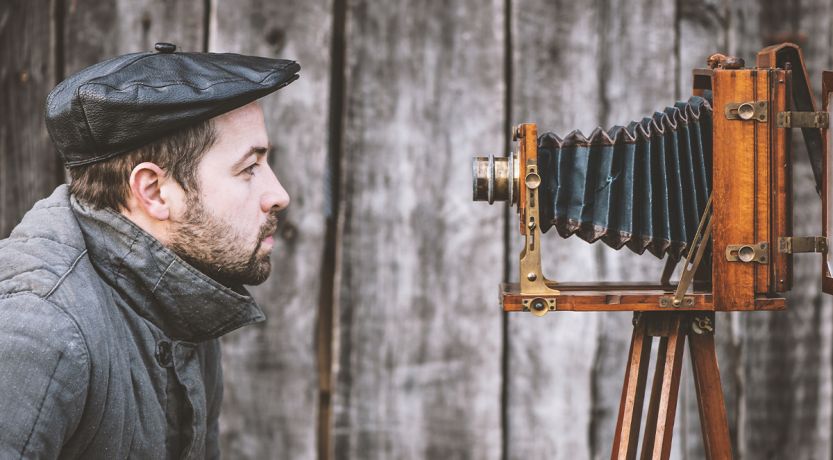Many say the camera doesn’t lie—but cameras are more misleading than you might realize. (A lesson about the God who sees all and never lies.)
In 1824 Joseph Nicéphore Niépce took a picture with his camera.
That might not sound like a big deal—except for the fact that, until that day, no one had managed to take a permanent photograph before. Niépce’s camera was the end result of centuries’ worth of research and theories in the scientific community, and his picture marked the birth of the world of photography.
By 1839 the first commercially available cameras were on the market—and while it would be another half a century before George Eastman released his affordable Kodak model, it was now officially possible to document life through the lens of a camera.
The world would never be the same.
“The apparatus can’t mistake”
Thirty-five years after Niépce took his groundbreaking photograph, a play called The Octoroon debuted in New York. One of the characters has a camera of his own and is used to hearing “the homely folks” complain that their portraits don’t look right. He often explains, “The apparatus can’t mistake. … You may mistake your phiz [face] but the apparatus don’t.”
(If they continue to complain that the photograph wasn’t agreeable, he follows up with a reminder that “the truth seldom is.”)
The apparatus can’t mistake. Sound familiar? Over time, the phrase has morphed a little, but the sentiment hasn’t. You’ve probably heard (or even used) the modern-day equivalent:
“The camera doesn’t lie.”
Strange thought, that.
Niépce used a cumbersome box that had to be pointed at a subject for multiple days while the sun burned that image into the bitumen coating of a lithographic stone.
Today, there are phones with lenses and sensors smaller than your fingertip designed to record not just a single frame, but entire videos—60 frames captured every second, each one recorded in 4K resolution and accompanied with perfectly crisp audio.
Two centuries of constant tweaks and upgrades, and yet the one thing that never really went away is the idea that the camera can’t lie.
Except, of course, it can.
And it does.
And it always will.
How the camera lies
It’s not really the fault of the camera. The camera is an impartial tool—but it’s a limited tool. It’s easy to think of a single photograph—or even an entire video—as capturing an accurate glimpse of reality. We like to believe that cameras capture the truth of a situation and preserve it for us to analyze with perfect objectivity.
But it’s not that simple.
Think about what happens when you click the shutter of a camera. You’re recording a specific fraction of a second, from a specific angle, using a specific depth of field, all filtered through a specific lens during specific lighting conditions. Change any of those variables—just a single one—and the picture will change too. Sometimes dramatically.
Swapping from a wide-angle to a telephoto lens can make people look like they’re standing closer together than they really are. Repositioning a few light sources can turn a cheerful scene into one that’s ominous and foreboding. Narrowing the depth of field can draw attention to a single detail while blurring out the rest of the scene.
As historical records, pictures and videos are inherently imperfect—and that’s when they’re not being intentionally manipulated.
Videos can be manipulated in similar ways—and a few more. Videographers have to make decisions about audio fidelity and frame rates, both of which impact how the finished product is perceived.
As historical records, pictures and videos are inherently imperfect—and that’s when they’re not being intentionally manipulated.
“The dry plate can fib as badly as the canvas”
As technology develops, it’s becoming easier than ever to create misleading images and footage—although it was never impossible. In 1895 the Lincoln, Nebraska, Evening News remarked, “Photographers, especially amateur photographers, will tell you that the camera cannot lie. This only proves that photographers, especially amateur photographers, can, for the dry plate can fib as badly as the canvas on occasion.”
With the advent of post-processing software like Photoshop and After Effects, it’s almost a trivial thing to add, remove or completely transform elements of pictures and videos, turning them into records of moments that never actually happened. With filters and deepfake technology, you can even fake the shot before you take it.
But visuals can be misleading even without the use of fancy software—all you need is false or fuzzy context. Images—moving or still—are powerful, and often take on a narrative of their own.
Take The Roaring Lion, the iconic portrait of Winston Churchill. You’ve almost definitely seen it—the steely glare of the prime minister who led his country through the darkest days of World War II. His look of resolute determination and indefatigable focus holds the gaze of the camera without apology.
As the USC Fisher Museum of Art put it, “That defiant and scowling portrait became an instant icon of Britain’s stand against fascism.”
Do you know why Churchill was scowling in that portrait?
Because the photographer took away his cigar.
It’s true. Look it up. The photographer, Yousuf Karsh, didn’t want Churchill’s cigar in the photo, and when the already grumpy Churchill ignored Karsh’s request, Karsh decided to remove the cigar himself.
“By the time I got back to my camera,” wrote Karsh, “he looked so belligerent he could have devoured me. It was at that instant that I took the photograph” (Faces of Our Time, 1971).
And that’s the story of the scowl—not a glimpse of Churchill’s determination to put an end to the Nazi scourge that threatened the world, but indignation at the audacity of the photographer who took his cigar.
But the world didn’t know that (at least, not for a while). Deprived of context, the picture told an entirely different story—and that’s the story that stuck.
(There’s a second, less-famous portrait from that session—a smiling Churchill, amused by Karsh’s stunt. That’s worth looking up too.)
How skeptical should we be of pictures?
To recap: the apparatus can make mistakes. Cameras lie (or at least misrepresent the truth) all the time, automatically, unintentionally. Because of those inherent limitations, it is impossible for photos and footage to convey anything more than a fragment of the bigger picture.
When we treat that fragment as the complete picture, it’s easy to walk away with a distorted view of a situation.
So what’s the lesson here? Treat every visual aid with extreme suspicion and always assume that everything you see is part of a bigger conspiracy to manipulate public opinion?
Not exactly. It’s important to be aware of the natural shortcomings and pitfalls of visual media, and it’s doubly important to be aware that there are people out there who are all too happy to take advantage of those shortcomings.
But the real question here isn’t about how paranoid we should be—it’s about who we should trust.
God sees what the cameras can’t
To truly capture everything happening in a given situation, a camera would have to be omnipresent and omniscient—existing everywhere, observing everything.
There’s not a camera in the world that can do that—but there is a God who can.
The Bible tells us that “the eyes of the LORD run to and fro throughout the whole earth” (2 Chronicles 16:9). But God operates with more than just a satellite view of the earth: “And there is no creature hidden from His sight, but all things are naked and open to the eyes of Him to whom we must give account” (Hebrews 4:13).
Imagine being able to see everything.
All at once.
All the time.
And not just to see it, but to understand it, to comprehend it, and to know what to do about it. Imagine knowing all of that and then going one step further—seeing beyond the physical world and into the hearts and minds of the entire earth. “For the LORD does not see as man sees; for man looks at the outward appearance, but the LORD looks at the heart” (1 Samuel 16:7).
That’s what God sees.
Trusting God to see what we can’t
Niépce’s incredible invention of the camera gave us a way to record moments in time and space—but that’s all they are. Moments. Slivers of a much bigger something. And even when we have access to 10,000 of those slivers in high definition and with clear audio, we still aren’t seeing everything there is to see. We can’t possibly.
And we do our worldview a disservice when we think a few minutes of footage or a well-framed picture is enough to give us perfect insight into every unseen layer and complicated facet of a given situation.
The good news is that we don’t need to have that insight. We just have to trust the God who does have it. And, in sharp contrast to the camera, which can’t help but distort the truth, the God that we serve “cannot lie” (Titus 1:2).
That’s an incredible description. This verse doesn’t say “God, who will not lie,” but, “God, who cannot lie.” Deception and dishonesty are so far from His nature that the very thought of lying is abhorrent to Him (Proverbs 6:16-19).
As Christians, we have to trust that the God who cannot lie—the God who sees all things as naked and open—the God who holds the depths of the earth in His hands (Psalm 95:4)—has the power and wisdom and character to handle things that are bigger than we are. We have to trust that He has the perspective and the knowledge to lay out the rules dividing “life and good, death and evil” (Deuteronomy 30:15).
Then we have to go one step further, putting that trust into action by following where He leads and living like He commands.
The camera always lies. Better to trust the God who can’t.
Want to get to know God a little better? Try our seven-day Journey “Knowing God.”






